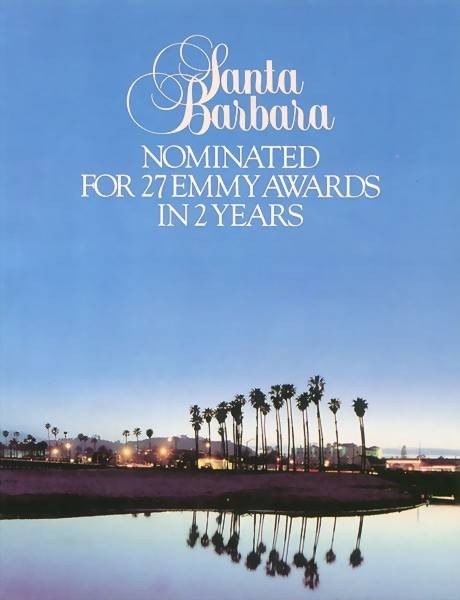Worlds Without End : The Art and History of the Soap Opera, 1997
|
|
Home | Cette page en Français |
| Santa Barbara | |||||
|
Worlds Without End : The Art and History of the Soap Opera, 1997 |
|
||||
 Only
the second daytime drama to debut in the hour format (the first was Texas
in 1980), Santa Barbara was a product of the post-General
Hospital soap world. Here, the romantic fantasies of youthful viewers
had replaced the domestic interests of housewives as the focus for storylines.
Shows abandoned their "guidebook for living" morality in favor of a
more contemporary attitude. Bridget and Jerome Dobson, the daughter and
son-in-law of General Hospital creators Frank and Doris Hursley,
had successfully updated the venerable serials Guiding Light and As
the World Turns when NBC commissioned them to create their own show. The
result, which debuted on July 30, 1984, was a classically structured soap opera
with a perverse soul. It was also one of the most irreverent, humorous,
outrageous, and intelligently written television serials ever produced.
Only
the second daytime drama to debut in the hour format (the first was Texas
in 1980), Santa Barbara was a product of the post-General
Hospital soap world. Here, the romantic fantasies of youthful viewers
had replaced the domestic interests of housewives as the focus for storylines.
Shows abandoned their "guidebook for living" morality in favor of a
more contemporary attitude. Bridget and Jerome Dobson, the daughter and
son-in-law of General Hospital creators Frank and Doris Hursley,
had successfully updated the venerable serials Guiding Light and As
the World Turns when NBC commissioned them to create their own show. The
result, which debuted on July 30, 1984, was a classically structured soap opera
with a perverse soul. It was also one of the most irreverent, humorous,
outrageous, and intelligently written television serials ever produced.
Although the show set out to tell the story of four families - the Lockridges, Capwells, Perkins, and Andrades - Santa Barbara, from the beginning, focused primarily on the wealthy, and extremely dysfunctional, Capwells. The most troubled of them all was oldest son Mason. Resigned to the fact that he would never get the approval of his father that he desperately wanted, the Shakespeare-quoting attorney drowned his sorrow in alcohol, sought redemption in the arms of former-nun Mary Duvall, and eventually found true love with Julia Wainwright, a fellow lawyer whose demons mirrored his own. The unrelenting melancholy of his story was relieved by the more traditional Romeo and Juliet pairing of perpetual victim Eden Capwell and Hispanic detective Cruz Castillo. The romance of their relationship, with Oceanside horseback rides, a champagne proposal, and an extravagant wedding - all shot on location - helped define the lavish visual look of the show.
Santa Barbara's stories enjoyed some of the best-written soap opera since the heyday of Ryan's Hope. Dialogue was alternately sharp and biting, poetic and philosophical, emotional and heartbreaking. Situations were inventive. Characters made love in ambulances, smuggled themselves into the country in coffins, and were killed by falling signs. A series of spoofs, satires, and allegories provided a new way to explore characters' inner feelings, as in the annual Christmas visits of Kris (also known as Santa Claus) or Greg Richardson's trip to the "Capwell Zone," where he learned to come to terms with his newly discovered paternity and the alien family he was now part of. At times, perhaps because of the show's lack of a moral compass, the outrageousness misfired. A prime example was the revelation that the doctor who had examined Eden after her sexual assault was her rapist. But at other times, it perfectly captured the nuances and imperfections of the human condition, such as the strain that the reappearance of old-flame Robert Barr put on Eden and Cruz's relationship. Through it all, Santa Barbara earned a well-deserved reputation as a show willing to take any risk, try any gimmick.
Unfortunately, the storytelling was never able to match the wit and wisdom of the dialogue. While many critics loved the serial, and it developed a strong cult following, Santa Barbara never managed to make an impact on the wider, more traditional soap opera audience. To do so, the show would have had to sacrifice many of the elements that made it unique. Instead, it aired its final episode on January 15, 1993.
On
Santa Barbara
"I
was writing for Santa Barbara and directing Another World in
1989-1990, which was kind of fun because they were back-to-back on NBC. Santa
Barbara wasn't really a soap opera, and that's the reason its not still
on the air. It was just a crazy, fun, wild show that we did a lot of crazy stuff
on. It was much more like an episodic show. We won Best Show three years in a
row, and the next year it was off the air. Everybody said, "How can that
happen ?" We always had these great shows to submit for the Emmys and the
show was so quirky; everybody in the business loved it. But the audience wasn't
compelled to watch it from day to day, the way that Bill (Bell) or Agnes (Nixon)
compels you. We'd take a two-week period, tell a story, drop it, and move on to
something else. People were in and out and the show didn't have any history for
the audience to invest in."
Gary
Tomlin, director, One
Life To Live
|
|